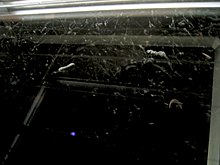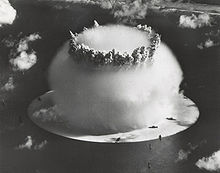Cloud chamber

This article relies largely or entirely on a single source. (August 2009) |
The cloud chamber, also known as the Wilson chamber, is used for detecting particles of ionizing radiation. In its most basic form, a cloud chamber is a sealed environment containing a supercooled, supersaturated water or alcohol vapor. When an alpha particle or beta particle interacts with the mixture, it ionizes it. The resulting ions act as condensation nuclei, around which a mist will form (because the mixture is on the point of condensation). The high energies of alpha and beta particles mean that a trail is left, due to many ions being produced along the path of the charged particle. These tracks have distinctive shapes (for example, an alpha particle's track is broad and straight, while an electron's is thinner and shows more evidence of deflection by collisions). When any uniform magnetic field is applied across the cloud chamber, positively and negatively charged particles will curve in opposite directions, according to the Lorentz force law with two particles of opposite charge. For more detailed track-shape information, see bubble chamber.
Invention
Charles Thomas Rees Wilson (1869-1959), a Scottish physicist, is credited with inventing the cloud chamber. Inspired by sightings of the Brocken spectre while working on the summit of Ben Nevis in 1894, he began to develop expansion chambers for studying cloud formation and optical phenomena in moist air. Very rapidly he discovered that ions could act as centers for water droplet formation in such chambers. He pursued the application of this discovery and perfected the first cloud chamber in 1911. In Wilson's original chamber the air inside the sealed device was saturated with water vapor, then a diaphragm is used to expand the air inside the chamber (adiabatic expansion). This cools the air and water vapor starts to condense. When an ionizing particle passes through the chamber, water vapor condenses on the resulting ions and the trail of the particle is visible in the vapor cloud. A diagram of Wilson's apparatus is given here. Wilson, along with Arthur Compton, received the Nobel Prize for Physics in 1927 for his work on the cloud chamber. This kind of chamber is also called a pulsed chamber, because the conditions for operation are not continuously maintained. The cloud chamber was the first radioactive detector.
Other particle-detection chambers
The diffusion cloud chamber was developed in 1936 by Alexander Langsdorf. This chamber differs from the expansion cloud chamber in that it is continuously sensitized to radiation, and in that the bottom must be cooled to a rather low temperature, generally as cold as or colder than dry ice. Alcohol vapor is also often used due to its different phase transition temperatures. Dry-ice-cooled cloud chambers are a common demonstration and hobbyist device; the most common fluid used in them is isopropyl alcohol, though methyl alcohol can be encountered as well. There are also water-cooled diffusion cloud chambers, using ethylene glycol.
The bubble chamber was invented by Donald A. Glaser of the United States in 1952, and for this, he was awarded the Nobel Prize in Physics in 1960. The bubble chamber similarly reveals the tracks of subatomic particles, but as trails of bubbles in a superheated liquid, usually liquid hydrogen. Bubble chambers can be made physically larger than cloud chambers, and since they are filled with much-denser liquid material, they reveal the tracks of much more energetic particles. These factors rapidly made the bubble chamber the predominent particle detector for a number of decades, so that cloud chambers were effectively superseded in fundamental research by the start of the 1960s.
The newer spark chamber is an electrical device that uses a grid of uninsulated electric wires in a chamber, with voltages applied between the wires. Microscopic charged particles cause some ionization of the air along the path of the particle, and this ionization causes sparks to fly between the associated wires. The presence and location of these sparks is then registered electically, and the information is stored for later analysis, such as by a digital computer.
Wilson cloud

When a nuclear weapon is detonated in humid air, the "negative phase" of the shock wave causes a rarefaction (reduction in density) of the air surrounding the explosion, but not contained within it. This rarification results in a temporary cooling of that air, which causes a condension of some of the water vapor contained in it. When the pressure and the temperature return to normal, the Wilson cloud dissipates.[1] Scientists observing the Operation Crossroads nuclear tests in 1946 at Bikini Atoll named that transitory cloud a "Wilson cloud" because of its superficial similarity to the appearance of the inside of a Wilson cloud chamber. (The cloud chamber effect is caused by electrically-charged sub-atomic particles, not by a pressure wave.) Analysts of nuclear bomb tests later used the more general term "condensation cloud" for the "Wilson clouds".
The same kind of condensation cloud is sometimes seen above the wings of low-altitude jet aircraft in a quite moist atmosphere. The top of a wing is the more-curved surface, and the curvature (and increased air velocity there) causes a reduction in the air pressure right there, as given by Bernoulli's Law. This reduction in air pressure causes a cooling, just as above, and the condensation of water vapor. Hence, the small, transient clouds that appear.
In technical terms, the "Wilson cloud" is also an example of the Prandtl–Glauert singularity in aerodynamics.
References
Das Gupta, N. N. (1946). "A Report on the Wilson Cloud Chamber and its Applications in Physics". Reviews of Modern Physics. 18: 225–365. doi:10.1103/RevModPhys.18.225. {{cite journal}}: Unknown parameter |coauthors= ignored (|author= suggested) (help)
- ^ Glasstone, Samuel and Philip J. Dolan. The Effects of Nuclear Weapons, U.S. Dept. Of Defense/ Dept. Of Energy; 3rd Edition edition (1977), p. 631
